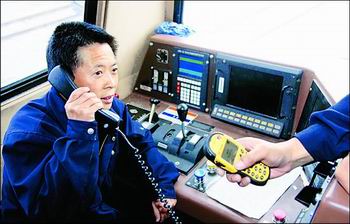| Tools: Save | Print | E-mail | Most Read |
| Mobile Network to Cover 95% of Qinghai-Tibet Railway |
| Adjust font size: |
With 80 percent coverage already in place, a mobile communications network along the Qinghai-Tibet Railway which travels at the highest elevation in the world will reach 95 percent in the future, Chinanews.com reported on July 31. The second-stage of the Global System for Mobile Communications (GSMC) project starts later this year.
A Damxung herder, standing along the Qinghai-Tibet Railway, called his friend June 25, 2006. Currently, the communication grid has basically covered all the areas along Qinghai-Tibet Railway. According to the report, passengers can now send and receive messages and calls by mobile phones on most sections of the 1,142-km-long railway from Golmud to Lhasa. It is even possible for the travelers to take pictures with mobile phones and send them to their relatives and friends. Zheng Aijun, general manager of the Qinghai Mobile Communication Co. Ltd. (Qinghai Mobile), said the railway runs across more than 1,400 km in Qinghai provincial territory with a 350-km section at more than 4,800 meters above sea level. Qinghai Mobile built 18 communication stations along the railway which resulted in the mobile network covering 80 percent of the Golmud-Tanggula Mountain Pass section and 95 percent of the Xining-Golmud link. Zhu Dasun, deputy general manager of the Tibet Mobile Telecommunications Co. (Tibet Mobile) said his company had built 21 new mobile stations in the Tibet Autonomous Region which raised the total number to 41. The railway runs across more than 580 km in Tibet with mobile network covering 85 percent of the area along the route. Network benefits travelers and residents According to the Golmud Mobile Telecommunications Co. (Golmud Mobile), the designers of the network fully considered the demands of travelers as well as those living alongside the railway line as well as the Qinghai-Tibet Highway line.
Railway workers test radio communications equipment in the Golmud Railway Station With the GSMC project covering the route of the Qinghai-Tibet Railway, it means 80 percent of the Qinghai-Tibet Highway will also be covered, according to Qinghai Mobile. Zhang Hailin, a truck driver from the China Tiesiju Civil Engineering Group Co. Ltd., said his truck sunk deep into mud at Chaidanyinma Gorge on June 15. Zhang was surprised to find that what was considered a communications "black spot" had a mobile signal and he was able to call for assistance. Currently there are more than 4,000 km of optical cables in Tibet and access to the mobile network is available along trunk roads and in major towns and important frontier strongholds, according to the local government. Mobile stations in the scenic spots of Nam Co, Yangdork Lake, Mount Qomolangma and areas along the Qinghai-Tibet Highway provide convenience not only for travelers but also for local residents. Access to telephones is available in 88 percent of villages in Qinghai Province. To guarantee communications continuity Qinghai Mobile has employed 100 new network maintenance personnel. Second-stage network project to be launched soon The mobile network along the Qinghai-Tibet Railway was built in very difficult conditions – high elevation, severe cold and frozen soil. With the completion of the first-stage GSMC coverage project, the two mobile companies have planned second-stage tasks. The problems which require to be solved relate to the width and depth of network coverage. On width the communications signals must cover all the areas along the railway and on depth the mobile service must include various things like access to multimedia messaging services and general packet radio services.
Construction workers on a tower frame checking communications equipment in the Golmud Railway Station. Maintenance and security of communications facilities are the two other challenges facing the mobile companies. According to Tibet Mobile, between March 2005 and April 2006 more than 3,000 pieces of solar equipment and transformers valued at more than 1.5 million yuan (about US$188,000) were stolen. The reason to use solar equipment as a power source is that high voltage power along the Qinghai-Tibet Railway simply can't meet the demand. Although the power source built for railway communications can meet the demand, China Mobile and railway departments haven't reached an agreement yet on resource sharing. Solar equipment is costly but also limited by weather. If it rains for three days in a row the equipment can't supply power for mobile stations and communications can't operate normally. To protect communication facilities, mobile companies must employ local people to work in shifts. Each station will cost more than 20,000 yuan (US$2,509) each year to ensure everything is operating correctly. Currently, mobile business volume along the Qinghai-Tibet Railway remains small and won't make profits in the short term. Coordination and sharing of resources between related departments seem to be a better approach to ensuring that mobile networks best serve the people. (China.org.cn by Li Jingrong, August 4, 2006) |
| Tools: Save | Print | E-mail | Most Read |
 |
| Related Stories |
| Product Directory China Search |
Country Search Hot Buys |


